Thu 10 May 2012
Mike Nevins on ESQUIRE, HARRY STEPHEN KEELER, HENRY KANE and JAZZ NOIR.
Posted by Steve under Authors , Columns , Magazines[17] Comments
by Francis M. Nevins
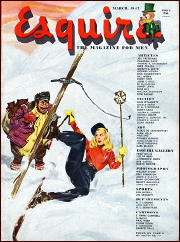
During the last months of World War II the editors of Esquire decided to launch a series of short detective stories and invited various mystery writers to create new characters for possible publication in the magazine.
Among the invitees was Harry Stephen Keeler (1890-1967), perhaps the nuttiest author on earth. Harry got miffed at the thought of being asked to “submit a sample like a guy with a tin cup†and demanded $100 in advance. He must have fallen on the floor in shock when Esquire immediately sent him a check, although the editors specified that the advance wasn’t a commitment to accept his submission.
Keeler proceeded to string together a 14,000-word adventure about a barking clock and an astigmatic witness, with a 7½-foot-tall mathematically educated hick from the sticks serving as detective. At first the character was named just that — Abner Hick to be precise — but before sending out the manuscript Keeler prudently changed his name to Quiribus Brown.
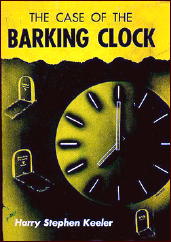
When Esquire rejected the story, Keeler yanked Quiribus out of the plot, replaced him with that bedraggled old universal genius Tuddleton T. Trotter (who had starred in Harry’s mammoth extravaganza The Matilda Hunter Murder back in 1931), and added 85,000 more words to the story.
His Spanish publisher Instituto Editorial Reus issued the result as El Caso del Reloj Ladrador (1947). Keeler’s U.S. publisher, the bottom-rung Phoenix Press, put out a shorter version that same year as The Case of the Barking Clock.
Since Phoenix dropped Keeler in 1948, leaving him without a U.S. publisher for the rest of his life, Quiribus never saw the light of print in his native land. But Harry made him the protagonist in The Case of the Murdered Mathematician, issued in 1949 by his London publisher Ward, Lock.
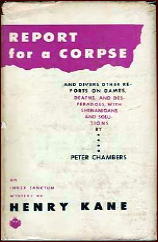
So what new detective was chosen to grace the pages of Esquire? A New York PI named Peter Chambers whose creator was Henry Kane, a lawyer and something of a Chandler wannabee. Chambers narrates his own cases in an idiom, known to connoisseurs as High Kanese, which is worlds removed from Keeler’s style but just as lovably eccentric.
The first six Chambers stories appeared in Esquire between March 1947 and June 1948 and were collected as Report for a Corpse (Simon & Schuster, 1948).
The timing was unfortunate in the sense that the book came out several months after Anthony Boucher was let go as reviewer for the San Francisco Chronicle and before he became mystery critic of the New York Times. I’d love to know what Boucher thought of this volume, but it was his predecessor Isaac Anderson who reviewed the book in the Times.
I read the tales a few decades ago but had forgotten them completely when I started to reread them earlier this year. They’re more cleverly plotted than most PI stories during the years Chandler dominated the genre, but there’s nothing truly memorable about any of them and the narration is a pale shadow of what would soon become mature Kanese.
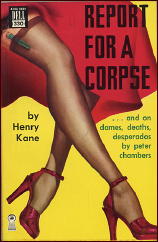
According to just about any print or electronic source you might check, Henry Kane was born in 1918 and is still alive. Apparently neither of these statements is true.
Lawrence Block had several conversations with Kane in the early 1970s and, while preparing a memoir of him for Mystery Scene, did some investigative work that was worthy of his own PI Matthew Scudder. An old girlfriend of Kane’s told Block that “he was most likely born not in 1918 but in 1908.†At least when Block knew him, he “lived on Long Island — Lido Beach, if memory serves — and spent Monday through Friday in an apartment on 34th Street west of Ninth Avenue.â€
Block tells us that he “took his work seriously, and insisted that each page be perfectly typed before he went on to the next one.†He was of Jewish descent but told Block that he “didn’t believe in any of that mumbo-jumbo.â€
His lifestyle was that of the stereotypical PI: a Dexedrine pill every morning, at least a quart of Scotch and a couple of packs of cigarettes a day. “It must have been sometime in the early ’80s that he died,†Block surmises.
Of the eleven Henry Kanes listed in the Social Security Death Index, the one who was born in 1908 and died in 1988 is most likely our man. I would love to have met him, though not necessarily in that smoke-choked apartment.
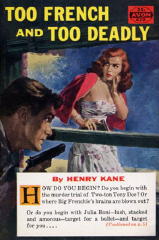
In his years as conductor of the “Criminals at Large” column for the Times, Anthony Boucher reviewed most of the Kane novels and collections, even though they were published in the unprestigious paperback-original format.
I still recall vividly the time he reviewed one of those novels twice. Its U.S. title was Too French and Too Deadly (Avon pb #672, 1955). In his Times column for December 18, 1955 he called the book “probably enjoyable; Peter Chambers stories are usually amusing, and this one is said to include ‘a locked room within a locked room.’
“But the publishers have chosen to crowd a full-length novel into 122 pages by squeezing 500 words onto a 4-inch by 6-inch page; and squinting one’s way through the book is too much to ask of a reviewer, a reader, or anyone save possibly a Lord’s-Prayer-on-Pinhead engraver.â€
Apparently Kane then sent Boucher a copy of the hardcover British edition, The Narrowing Lust (Boardman, 1956). In his column for June 24, 1956, Boucher reported that “now that it’s legible, it’s also highly readable†and “includes an unusually impossible-seeming locked room problem. It’s a welcome blend of strict detective puzzle and crisp and sexy thriller….â€
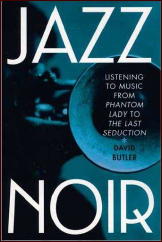
In my last column I quoted the late Fred Steiner, composer of the Perry Mason theme: “You look at those old film noir pictures, they’ve always got jazz going for some reason or other.â€
Since then I’ve discovered that this seems to be a classic case of false memory. The point was demonstrated by David Butler in his book Jazz Noir: Listening to Music from Phantom Lady to The Last Seduction (Praeger, 2002) and confirmed by William Luhr in his just published Film Noir (Wiley-Blackwell, 2012):
“Although many neo-noir movies have used single-instrument jazz solos to evoke the film noir era, it is difficult to find a canonical film noir [i.e. one that dates from the Forties or Fifties] that opens in that way. Most used full orchestral scores, as was standard studio practice.â€
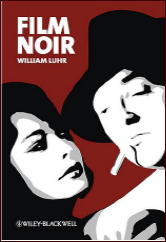
It’s only in TV private-eye series like Peter Gunn that jazz became the norm. And, as Lawrence Block points out, the strongest uncredited influence on that landmark series was the novels and stories of Henry Kane — who wound up writing the Peter Gunn tie-in novel (Dell pb #B155, 1960)!
Is this a weird world or what? Luhr’s book is one of the few that discusses in depth both canonical noir and the more recent evocations of the genre, of which perhaps the finest is Chinatown (1974). I recommend it highly to anyone invested in that type of film. And aren’t we all?
Previously on this blog:
A Corpse for Christmas, by Henry Kane. Reviewed by Bill Deeck.
Trinity in Violence, by Henry Kane. A 1001 Midnights review by Art Scott.
The Midnight Man, by Henry Kane. A 1001 Midnights review by Bill Pronzini.
A Corpse for Christmas, by Henry Kane. Reviewed by Steve Lewis.
Until You Are Dead, by Henry Kane. Reviewed by Steve Lewis.
A long quote from the latter book is included as a big chunk of the review.
May 11th, 2012 at 4:35 am
Mike,
The usual fascinating confluence of the trivial, the esoteric and the downright arcane–and they don’t come any arcaner than Keeler!
I read and enjoyed a non-PI book by Henry Kne a few yers back, but never had any desire to try a Peter Chambers tale.
May 11th, 2012 at 8:10 pm
Replying to Dan in Comment #1, Henry Kane turns out to be something of favorite on this blog. I surprised myself when I saw how many times his books have been reviewed here. I don’t know if I can convince anyone to read a Peter Chambers book, but here’s trying. Taken from my review of UNTIL YOU ARE DEAD , I said:
“As a writing stylist, Henry Kane is pretty good. Not in Raymond Chandler’s league, but he can rattle off the dialogue when he wants to, which is often, and he can go into philosophical matters with equal ease.”
And Art Scott said, in his review of TRINITY IN VIOLENCE: “The Chambers stories tend to be pretty routine private-eye capers, but Kane’s handling of this stock material is quite unusual. The characters deliver their lines in a peculiarly arch fashion, which veteran PI fans are equally likely to find either refreshingly novel or plain silly. ”
And Bill Deeck said, in his review of A CORPSE FOR CHRISTMAS: ” What kept me reading was Kane’s obvious love of the language and Chambers’s sense of humor. Kane has a delightful style, although I still haven’t figured out what a “saltatory mattress†might be.”
Three for three. We can’t all be wrong!
May 11th, 2012 at 12:00 pm
1. I want to read Barking Clock! Damn.
2. I really, really wish Boucher’s columns for the NY Times would be collected and published, as his ones for the San Francisco paper are! Come on, someone. Please!
3. I’ve seen a lot of noir films, and it had never occurred to me that they featured jazz in the soundtrack. I usually pay attention to the music, and am a jazz fan and I think I would have noticed it. So this comes as no surprise to me.
May 11th, 2012 at 12:59 pm
I didn’t know about either of the two Film Noir books that Mike mentions in his last section, and of the two, JAZZ NOIR sounds the more interesting.
Unfortunately it costs something like sixty bucks, which is out of my price range at the moment. So far I’ve had to be content with reading the snippets provided by Amazon.
One obvious use of jazz in a noir film is in PHANTOM LADY:
https://www.youtube.com/watch?v=5vEgZM5x0ik
Maximize the video to full screen for the best effect.
But the use of jazz music throughout a movie OR TV show, noir or not, didn’t come along until the mid to late 50s. It sounds like a fascinating book, and I’d like to know more. Maybe if I give some hints out for Father’s Day…
May 11th, 2012 at 1:28 pm
Scenes like the one of Elisha Cook in PHANTOM LADY, Deanna Durbin in CHRISTMAS HOLIDAY or Yvonne DeCarlo dancing with Tony Curtis in CRISS CROSS make me wish Siodmak had directed a musical.
May 11th, 2012 at 2:23 pm
I have no idea whether Symphonie D’Amour (1936/1946-US) was a musical, but it doesn’t sound particularly noirish, does it? It wasn’t until recently that I realized that Robert Siodmak had made so many movies in the 1940s that I’ve enjoyed many times over. (Sometimes I’m slow on the realization of things.)
Getting back to jazz soundtracks in the movies, I’ve found a list of milestones in the JAZZ NOIR book (via an Amazon glimpse) that says the first film to use an extensive jazz-based score was A STREETCAR NAMED DESIRE in 1951. The first noir film with a jazz score, he says was I WANT TO LIVE! in 1958. (Music by Johnny Mandel.)
May 11th, 2012 at 3:23 pm
Other than hysteria and a fallen woman at its center, I don’t see I Want To Live as noir. Rather, a semi-documentary tract railing against he death penalty.
May 11th, 2012 at 3:29 pm
Steve, you will find a bigger sample of JAZZ NOIR at google books.
May 11th, 2012 at 7:54 pm
Barry
It’s fairly borderline to me, too. That’s why I phrased my comment the way I did, that it was Butler’s statement, not mine.
Thanks to Michael for suggesting Google books, I did some more searching in JAZZ NOIR for what else Butler had to say about I WANT TO LIVE.
You get mostly snippets, but a lot more of them than you do with Amazon. Butler refers to the movie quite a few times, but there’s at least one instance where he seems to agree that I WANT TO LIVE! is Noir only if you stretch the definition more than you should (page 154).
I don’t know if this URL will be of any good, since it’s the result of a search, but I’ll give it a try anyway:
http://books.google.com/books?ei=fK-tT5CvFqSj2QXz-MHpCA&id=b6Tkiq1lcl4C&dq=jazz+noir&q=i+want+to+live#v=snippet&q=i%20want%20to%20live&f=false
May 11th, 2012 at 8:01 pm
Getting back to Richard in Comment #2, TCOT BARKING CLOCK should be available from Ramble House in an inexpensive paperback reprint edition, $20 or so.
Anyone wanting a copy of Phoenix Press edition ought to be prepared to shell out $125 or more.
May 11th, 2012 at 10:44 pm
Saltatory means specialized for or characterized by jumping. So, in a PI story what might make a mattress jump? I’m sure we can all imagine.
May 11th, 2012 at 11:19 pm
I suppose it depends on the context.
Or, maybe not.
May 12th, 2012 at 12:35 am
I have got a double cd “film noir”. The first cd contains original soundtracks from noir films. The second cd contains jazz in the spirit of film noir, for example “Laura” by Duke Ellington or “Key Largo” by Benny Carter. The cds are connected with a short comic by the French comic artist Loustal in a booklet. The adress of the firm is: http://www.nocturne.fr/www.franceinter.com.
The order number is:ISBN 9782849072424.
May 12th, 2012 at 2:41 am
Josef
I couldn’t get my old clunker of a computer to see anything at that site, but I did find a Greek site that had it for sale.
http://xilouris.gr/catalog/product_info.php?products_id=6654&language=en
Price: only 25 Euros, but I forgot to find out what the shipping might be.
Here’s a list of the tracks:
Cd1 music they were murdered by – original soundtracks
1 the maltese falcon opening theme
2 dooley wilson as time goes by
3 double indemnity opening theme
4 laura opening theme
5 nat king cole laura
6 mildred pierce opening theme
7 claudia drake i can¢t believe you are in love with me
8 anita ellis put the blame on mame
9 the big sleep opening theme
10 jo stafford too marvellous for words
11 anton karas the third man theme
12 king jacquet d.o.a. illinois jacquet
13 sunset boulevard opening theme
14 crossfire “ginie cause i¢m from virginiaâ€
15 jo ann greer i¢ve been kissed before
16 nat king cole blue gardenia
17 jo ann greer the blue pacific blues
18 leith stevens private hell 36
19 nat king cole i¢d rather have the blues than what i¢ve got
20 pete kelly & his big seven pete kelly¢s blues
21 elmer bernstein franky machine
22 jean wiener trio touchez pas au grisbi
23 larry adler, philippe-gerard du rififi chez les hommes
24 michel legrand le nantais la nuit
25 jo boyer bob le flambeur
cd2 music to be murdered by
1 benny carter angel eyes
2 illinois jacquet harlem nocturne
3 duke ellington laura
4 stan kenton conflict
5 chet baker the thrill is gone
6 leith stevens havana interlude
7 leith stevens easy mood
8 leith stevens daddy long legs
9 leith stevens joshua
10 leith stevens lilli
11 leith stevens dance of the lilliputian
12 leith stevens private blues
13 benny carter key largo
14 johnny mercer one for my baby
15 stan getz serenade in blue
16 miles davis moon dreams
17 elmer bernstein break up
18 elmer bernstein audition
19 clifford brown delilah
20 woody herman misty morning
21 roy eldridge i remember harlem
May 12th, 2012 at 1:19 pm
I’ve checked with Al Hubin about Henry Kane’s birth and death dates, and as usual he’s been leagues ahead of us mere mortals. The years 1908 to 1988 agree with his current records, and he adds that is name at birth was probably Henry Cohen.
Check it out at the online Addenda to Crime Fiction IV, Part 43, from last November:
http://www.crimefictioniv.com/Part_43.html
May 16th, 2012 at 3:43 pm
Amazing bit of trivia that Keeler was nearly published in ESQUIRE. He’s my brief overview of The Case of the Barking Clock taken from an old reading log:
“Another rehash of a favorite Keeler motif – the wrongfully imprisoned man who must race against time to prove his innocence lest he be executed. This is laugh out loud funny. I think at this point Keeler just gave up on all seriousness and started to parody himself and everything he ever wrote. There are so many of these stories about prisoners hoping against hope to be saved from the electric chair or from hanging it’s a wonder he could come up with yet ANOTHER variation of his very tired theme. Still it’s a madcap romp with characters making fun of Keeler’s rambling style. “Why doesn’t he get to the point?” a woman says while she reads a nonsensically rambling letter filled with non sequitars. She even picks up the phone and calls the guy because she loses her patience and – of course!—he’s not available. So she has to return to the letter which allows Keeler to go on and on for a few more pages before he really does get to his point. (Summer 2008)”
May 16th, 2012 at 4:44 pm
I haven’t read Keeler myself since the 7th grade. There was a closet at the back of the room filled with books students could read when they had all their work done for the day, and one of the books was THE FIDDLING CRACKSMAN. I was still reading the Hardy Boys at the time, so this was a big jump for a kid of 11 years old. I don’t remember anything about the book, except for the title, but it certainly made an impression on me, since I remember the title so well. Nor have I read another Keeler since.